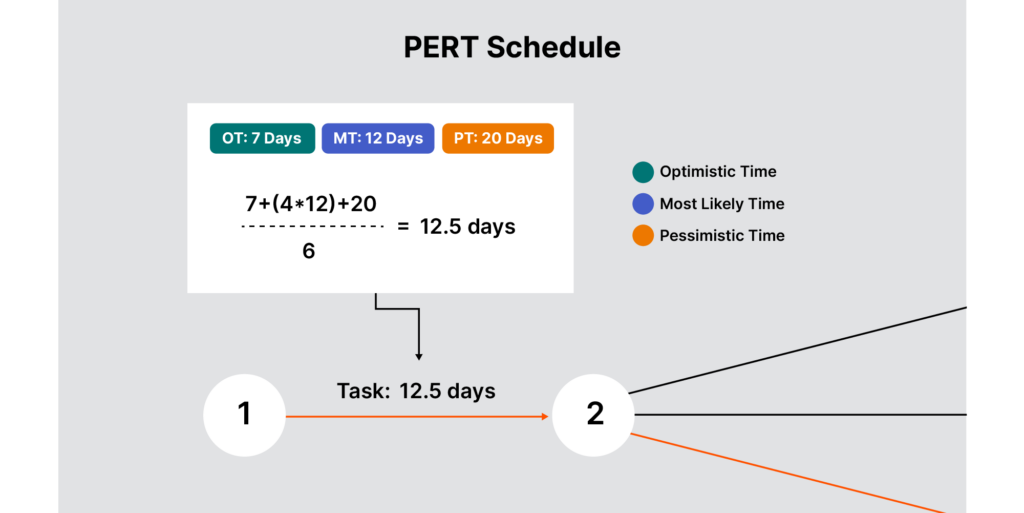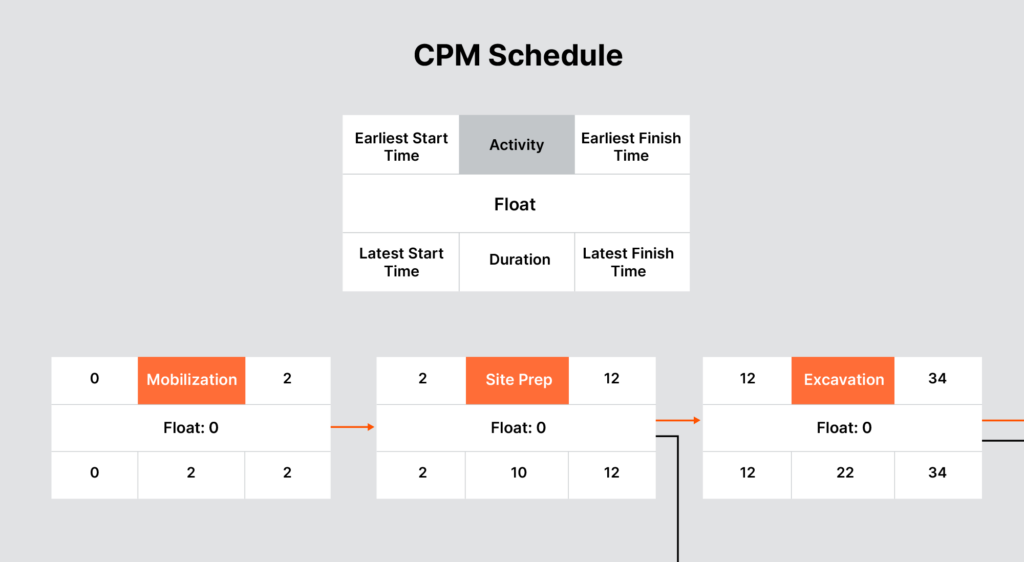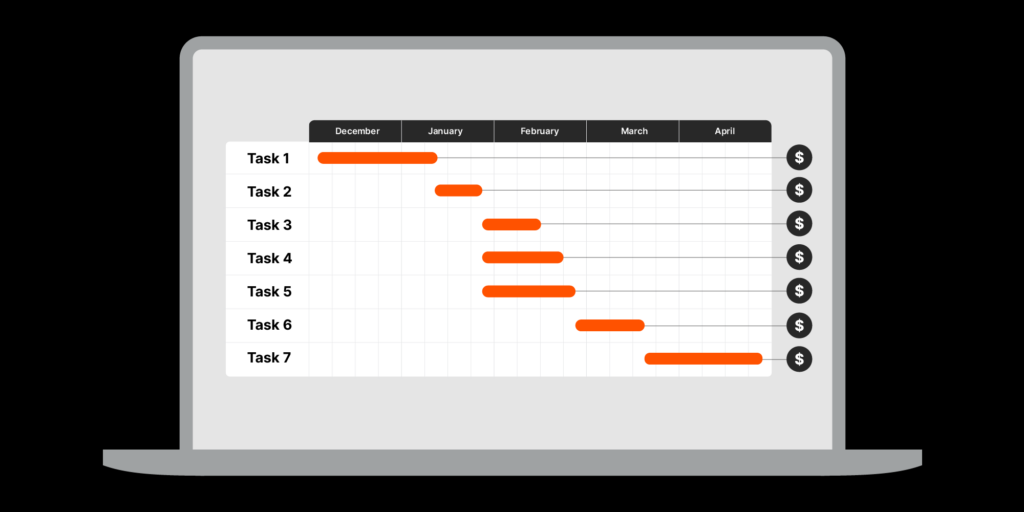— 6 min read
PERT vs. CPM: Comparing Construction Scheduling Methods


Last Updated May 30, 2025

Ben Ashburn
Staff Trainer & Program Manager
22 articles
Ben Ashburn is a Senior Construction Education Trainer at Procore. After a successful career as a construction estimator — working his way up from estimating manager to senior estimator — Ben has spent the most recent part of his career in construction sharing his skills with other as a construction educator. Ben has an extensive background in construction education: He has been an assistant professor in the Department of Construction Science at Texas A&M, and lectured about estimating, scheduling, management, and other related construction topics at Murray State University. He has been a construction training and learning development partner with Procore since 2019.

James Hamilton
Writer & Producer
85 articles
James Hamilton is a writer based in Brooklyn, New York with experience in television, documentaries, journalism, comedy, and podcasts. His work has been featured on VICE TV and on The Moth. James was a writer and narrator for the show, VICE News Tonight, where he won an Emmy Award and was nominated for a Peabody Award.
Last Updated May 30, 2025

Contractors should have an array of planning techniques to develop reliable schedules, accurate estimates and effective contingencies for even the most complex or uncertain projects. The Critical Path Method (CPM) and the Program Evaluation and Review Technique (PERT) are two helpful approaches to scheduling.
While CPM is much more common than PERT in construction, both scheduling approaches can serve different purposes. PERT gives a high-level overview of project milestones, while CPM provides a more detailed look at duration estimates for each activity.
In fact, these methods are not necessarily mutually exclusive. When approaching a task or project with an irregular or unpredictable scope, schedulers can effectively use both methods together to build a more accurate, achievable timeline even in the face of uncertainty.
Learn more: The Complete Guide to Construction Scheduling
Table of contents
Overview of PERT
PERT is a technique in which probabilistic time estimates are used to accurately forecast the duration of an activity or project, particularly those with a high degree of uncertainty. PERT uses a simple equation to calculate a weighted average of different time estimates.
The PERT method requires you to produce three time estimates:
- Optimistic Time (OT)
- Most Likely Time (MT)
- Pessimistic Time (PT)
You can then use the formula to calculate an average of the three, giving additional weight to the most likely time. The formula multiplies
PERT Weighted Estimate = OT + (4 * MT) + PT ÷ 6
When to Use PERT
PERT can be helpful for any task or activity where the duration isn’t known or is uncertain. For example, PERT would be useful in planning for constructing a highly specialized factory that is unlike other projects.
The technique is event-oriented, meaning it focuses on milestones and timelines and can be used for whole projects or for individual tasks. PERT can help build schedules that are less likely to have delays, which is why it is often deployed during the early stages of planning a project.
PERT Visualization
PERT is most often visualized as a sequence of project milestones, with the duration between them shown on the line connecting each one, known as activity-on-arrow.
PERT is most often visualized as a sequence of project milestones, with the duration between them shown on the line connecting each one, known as activity-on-arrow.

For example, two initial milestones on a project (mobilize to site and excavation) may be shown as nodes on a sequence of tasks. The time estimated between mobilization and excavation is shown on the arrow between the milestones.
Overview of CPM
The Critical Path Method (CPM) is an approach to scheduling that orders the tasks to complete a project (or phase of a project) and identifies the sequence of tasks that are most critical for the project to be delivered on time. CPM is one of the most common planning techniques in construction.
CPM defines a task’s latest and earliest start and finish dates, which can then be used to create actionable schedules for tasks found in the work breakdown structure (WBS), a common organizational system for complex undertakings like construction projects.
Identifying the Critical Path
The critical path is the longest sequence of tasks in a project or segment. Schedulers use the critical path method to identify the amount of float or slack available in each activity. The critical path is identified as the sequence of tasks without any float.
While all tasks are necessary to finish a project, the critical path consists of activities that can’t be delayed without having to change the schedule of activities. Subsequent activities depend on the completion of critical tasks.
Non-critical tasks, by contrast, are activities with more flexibility or float: They can often be completed concurrently with other activities. By identifying this critical sequence, contractors can prioritize allocation of resources — including equipment, materials and labor — while also determining when to schedule non-critical activities.
There are many ways to create a schedule using the Critical Path Method, including many digital planning tools that make it easy to organize, visualize, and share a schedule. Often, the planning tools include a Gantt chart to visualize a task’s duration, potential flex time, and overlapping work periods with different tasks.
When to Use CPM
CPM is a sequencing technique, meaning it focuses on identifying necessary tasks and how they relate to other tasks. In identifying critical and non-critical tasks, CPM is most useful in allocating resources.
However, CPM doesn’t help determine how long a task will take, so it’s often used for planning projects where most of the tasks and activities are familiar, and their durations are easy to anticipate. Since construction companies often have historical data on the duration of common activities – even if they are only stored in the scheduler’s memory – they can frequently estimate timelines without using a PERT formula.
CPM Visualization
Like PERT, CPM is typically visualized in a sequence of activities. However, each activity and information about its duration is shown on the node, known as activity-on-node.

Though the details can vary depending on the scheduler’s preference, a CPM schedule will generally display the following details for each activity:
- Activity name
- Duration
- Earliest start time
- Earliest finish time
- Latest start time
- Latest finish time
- Float or slack
The project manager will follow a series of steps using each of these details to identify the float, which will determine the critical path. This is why it is known as the Critical Path Method.
CPM vs PERT
CPM and PERT are not mutually exclusive scheduling methods. In fact, construction schedulers can use them both. However, CPM is generally much more common in construction.
| PERT | CPM | |
|---|---|---|
| Focus | Time management | Resource allocation |
| Visualization | Activity-on-arrow | Activity-on-node |
| Method | Milestone-oriented, focusing on milestones and timeframes. | Sequence-oriented, focusing on each task's completion. |
| Calculation | Offers a more robust risk analysis due to probabilistic time estimates. | Lesser focus on risk, more emphasis on resource allocation and cost. |
Using PERT & CPM Together
The difference between PERT and CPM can be a bit confusing, because the terms can be used in different contexts – they can refer either to the type of calculation or the type of visualization.
For example, PERT can refer either to the formula (shared earlier in the article) or the milestone chart. The PERT formula can be used in the development of a CPM schedule since it is simply a calculation to estimate a task’s duration. Similarly, a PERT schedule will almost always show the critical path, even when the Critical Path Method wasn’t used to identify it.
As contractors create a schedule using CPM, they will often be more confident in some of their duration estimates than others. With tasks of uncertain duration – or when historical data isn’t available to provide a more reliable estimate – they may use the PERT formula to calculate a duration.
Stay updated on what’s happening in construction.
Subscribe to Blueprint, Procore’s free construction newsletter, to get content from industry experts delivered straight to your inbox.

Different schedule visualizations may also be used for different project stakeholders. For example, a project manager can prepare a PERT schedule for an owner who wants to see project milestones without the distraction of extra details. However, when discussing the schedule with the superintendent, they would generally require the level of insight provided by a CPM schedule.
A good planner should have many tools that can be deployed, and CPM and PERT can be used separately or together to help create schedules that are precise and adaptable to the specific needs of each project.
Was this article helpful?
Thank you for your submission.
80%
20%
You voted that this article was . Was this a mistake? If so, change your vote
Scroll less, learn more about construction.
Subscribe to The Blueprint, Procore’s construction newsletter, to get content from industry experts delivered straight to your inbox.
By clicking this button, you agree to our Privacy Notice and Terms of Service.
Thank you!
You’re signed up to receive The Blueprint newsletter from Procore. You can unsubscribe at any time.
Categories:
Written by

Ben Ashburn
Staff Trainer & Program Manager | Procore Technologies
22 articles
Ben Ashburn is a Senior Construction Education Trainer at Procore. After a successful career as a construction estimator — working his way up from estimating manager to senior estimator — Ben has spent the most recent part of his career in construction sharing his skills with other as a construction educator. Ben has an extensive background in construction education: He has been an assistant professor in the Department of Construction Science at Texas A&M, and lectured about estimating, scheduling, management, and other related construction topics at Murray State University. He has been a construction training and learning development partner with Procore since 2019.
View profile
James Hamilton
Writer & Producer
85 articles
James Hamilton is a writer based in Brooklyn, New York with experience in television, documentaries, journalism, comedy, and podcasts. His work has been featured on VICE TV and on The Moth. James was a writer and narrator for the show, VICE News Tonight, where he won an Emmy Award and was nominated for a Peabody Award.
View profileExplore more helpful resources

Mastering Construction Resource Management: Strategies for Success
Completing construction projects successfully requires the careful management of various resources: labor, materials, equipment, money, time and information. Since these resources are finite, allocating them wisely is crucial for minimizing...

Cost-Loaded Construction Schedule: Analysis, Risks & Benefits
Both scheduling and cost control are make-or-break aspects of construction projects, but in many cases the two areas are kept very separate from one another — the project scheduler and...

Understanding the Last Planner System in Construction
Construction scheduling is a complex process affecting multiple stakeholders. Increasing accuracy and collaboration with trade partners when scheduling construction work can positively impact on-site workflow and efficiency. The last planner...

Forensic Schedule Analysis: Unlocking Insight Into Project Delays
Though construction sites may sometimes look like a large collection of machines, ultimately, it’s people who get things built. However, people aren’t perfect, and delays happen all the time —...
Free Tools
Calculators
Use our calculators to estimate the cost of construction materials for your next project.
Templates
Find a template to help you with your construction project tasks.
Material Price Tracker
Get the latest U.S. retail prices and view historical trends for common building materials.
Glossary
Explore key terms and phrases used in the industry.
